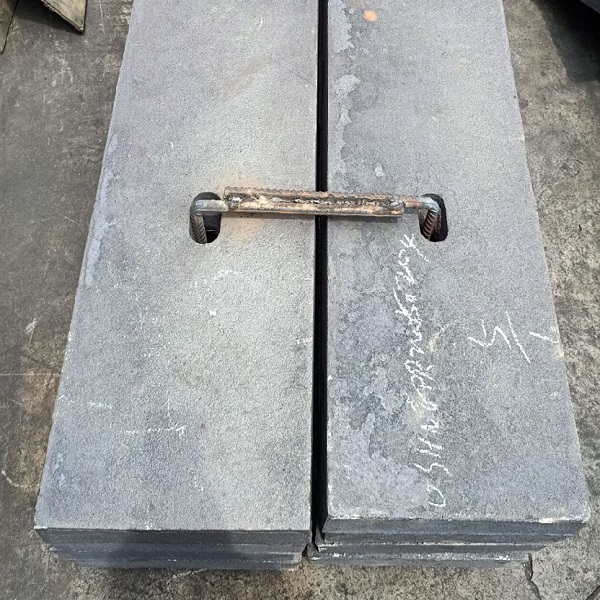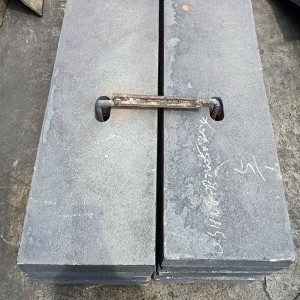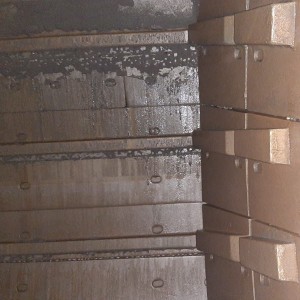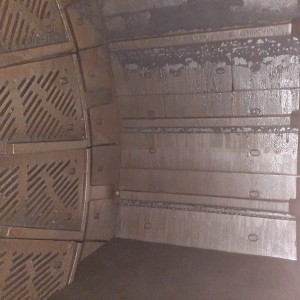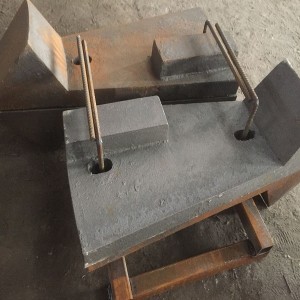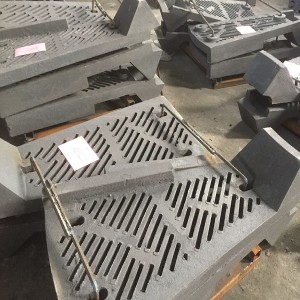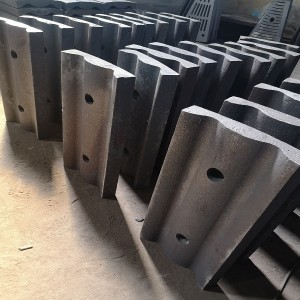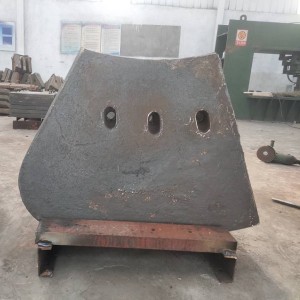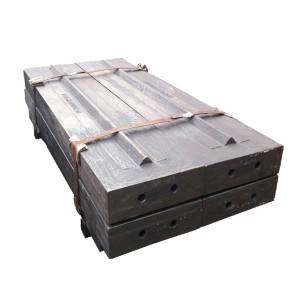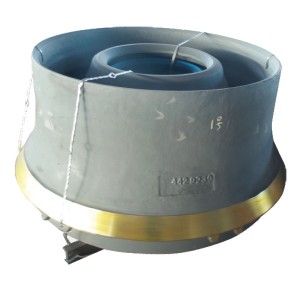Metso SAG Mill Shell Liner and Feeding Discharge Innner and Outer Mill Liner
Short Description:
Product Description
SAG Semi-Autogenous Grinding Mill Liner and AG Autogenous Grinding Mill Liner from H&G use Cr-Mo materials (AS2074 Standard), SAG Semi-Autogenous Grinding Mill Liner and AG Autogenous Grinding Mill Liner provides superior impact and wear resistance in all semi-autogenous milling applications.
To choose the right material for the right application is our mission , we are always working together with our customer to achieve this .The right material is upon to:
1. The mineral ground
2. Milling data information
3. Maximum grinding media diameter (mm)
4. Grinding media filling degree (%)
In general, Item M1 used for high impact condition ,P1 used for low impact condition. It shall change according to your mineral processing.
Specification Available
|
Code |
Chemical Elements(%)SAG Semi-Autogenous Grinding Mill Liner and AG Autogenous Grinding Mill Liner |
|||||||
|
C |
Si |
Mn |
Cr |
Mo |
Cu |
P |
S |
|
|
P1 |
0.6-0.9 |
0.4-0.7 |
0.6-1.0 |
1.8-2.5 |
0.25-0.5 |
0-0.5 |
≤0.04 |
≤0.06 |
|
M1 |
0.3-0.45 |
0.4-0.7 |
1.3-1.6 |
2.5-3.5 |
0.6-0.8 |
0-0.5 |
≤0.04 |
≤0.06 |
Physical Property & Microstructure
|
Code |
Hardness(HB) |
Ak(J/cm2) |
Microstructure |
|
P1 |
325-375 |
≥50 |
P |
|
M1 |
350-400 |
≥75 |
M |
|
M-Martensite, C-Carbide, A-Austenite, P-Pearlite |
|||
Note: Adjust the chemical content or add other alloying elements of SAG Semi-Autogenous Grinding Mill Liner and AG Autogenous Grinding Mill Liner according to customer needs is available.
Product Package
● Steel Pallet, Wooden Pallet and Wooden Box


● Customized according to special packing requirement.
Our Advantage
At H&G Casting, we engineer innovative designs, tailored especially for every customer. Our SAG Semi-Autogenous Grinding Mill Liner and AG Autogenous Grinding Mill Liner are manufactured to the highest industry standard for Autogenous Grinding(AG), Semi-Autogenous Grinding(SAG), Primary / Secondary and re-grind rod or ball mills. MGS Casting mill lining system designed by our highly trained, and dedicated team throughout the world has taken your entire comminution circuit into consideration. Supporting our front line Mill Engineers is a large team of extremely specialized design engineers, material chemists, manufacturing and logistics experts responsible for delivering exceptional service.
Optimal mill designs engineered by our team take into consideration service life; grind & power efficiency and ore characteristics, along with costumer circuit constraints both up and downstream of the mill lining.
H&G Casting had success to use ASTM 2074/L2B alloy steel to manufacture AG/SAG mill liners. Under this material, our mill liners span life can be obviously improved. Our Australia customers had ordered more than 10,000 tons per year of this material mill liners.
As a casting foundry, H&G Casting also has own SAG Semi-Autogenous Grinding Mill Liner and AG Autogenous Grinding Mill Liner design. In general terms, lifter spacing and angle, grate open area and aperture size, and pulp lifter design and capacity must be considered. Each of these topics has had a considerable amount of research, and numerous case studies of evolutionary liner design have been published. Based on experience, mill liner designs have moved toward more open shell lifter volumetric capacity and a grate design to facilitate maximizing both pebble-crushing circuit utilization and SAG mill capacity. Mill throughput is maximized with shell lifters between ratios of 2.5:1 and 5.0:1. This ratio range is stated without reference to face angle; At equivalent spacing-to-height ratios, lifters with greater face angle relief will have less packing problems when new but experience higher wear rates than those with a steeper face angle. Pulp lifter design can be a significant consideration for SAG mills, particularly for large mill. All mill sizes increases, the required volumetric capacity of the pulp lifters grows proportionally to mill volume.
Semi-autogenous grinding mill liner also called SAG mill liner, Autogenous grinding mill liner also called AG mill liner. Since the 2014 year, H&G Machinery has had become one of the largest AG/SAG mill liner manufacturers from China. No matter which material you want, manganese steel or Ni-hard steel or Cr-Mo steel or alloy steel; No matter which type of your mill liners need. wave shape or raised edge shape or stepped shape; H&G Machinery is your first choice.
Which Choose H&G Machinery’s AG/SAG Mill Liners?
- Rich experience. H&G Machinery supplies more than 10,000 tons of various kinds of mill liners.
- Various material. We offer different materials to suit different work conditions. Such as manganese steel, Ni-hard steel, Cr-Mo steel, and other alloy steels.
- Complete QC system. H&G Machinery supply a complete quality control system and records. You can check all the documents and records when you visit us or we send them to you.
- OEM service. H&G Machinery can manufacture your liners by your design or our engineer design.
When it comes to austenitc manganese steel mill liners, H&G Mill Liners had focused this material for long time. Our austenitc manganese steel mill liners span life more than other foundries mill liners.
This material used for grid liners, and generally smaller mills. Its great advantage is that it work hardens under stress, yet the substrate remains tough and can withstand extreme impacting without fracture. Its primary disadvantage is that it spreads with impact, so solid liners begin to squeeze together and become extremely difficult to remove, and can damage a mill shell if the stress is allowed to build up to an extreme level.
Austenitic manganese steel’s ability to work harden from impact loading along with its exceptional toughness make it the best wear material choice for many demanding applications.The hardness of manganese steel in the solution annealed and water quenched condition is normally around 220 HB. It is possible to strain harden this material to approximately 500 HB. In order to achieve this high hardness level, the impact loading must be high while the material wearing away from gouging abrasion is limited. It is typical in crushing applications were the main wear mechanism is gouging abrasion that the manganese steel will harden to some intermediate level, typically 350-450 HB.
When it comes to low carbon chrome moly steel mill liners, H&G Mill Liners had focused to cast this material for our customer. Our low carbon chrome moly steel mill liners span life more than other foundries mill liners.
This material also called AS2074 L2B steel.This steel is generally used for mill liners (AG,SAG and Ball) prior to the movement to higher carbon content steels. It has excellent wear characteristics with some impact resistance, generally now used for discharge grates where slightly better impact resistance is required compared to the higher carbon chrome moly steels or for thinner section liners.
Chrome Moly Steel Chemical Composition
| Material Grade | C | Si | Mn | P | S | Cr | Mo |
| AS2074 L2B | 0.55-0.65 | <0.75 | 0.50-1.00 | <0.06 | <0.06 | 0.80-1.50 | 0.20-0.40 |
| AS 2074 L2C | 0.70-0.90 | <0.75 | 0.50-1.20 | <0.06 | <0.06 | 1.30-2.40 | 0.20-0.40 |
Features
- Used for AG/SAG and ball mills ;
- Excellent wear characteristics and some impact resistance ;
- Metallographic structure of AS2074 L2B Steel is Pearlitic;
- Good for discharge grates;
- The hardness of AS2074 L2B is HB310-HB380.
When it comes to high carbon chrome moly steel mill liners, H&G Mill Liners had focused to cast this material for our customer. Our high carbon chrome moly steel mill liners span life more than other foundries mill liners.
This material also called AS2074 L2C steel.This steel is now considered the main material used for SAG mill liners. There are a number of variations with either different carbon or chrome contents. The variations tend to have a bearing on the size of the liner and its section thickness. There is ongoing development within this area as the size of the liners are outstripping the properties provided by the standard high chrome moly steels.
Features
- The material of SAG mill liners are low C or high C Cr-Mo Alloy steel,which depends on the specific working condition of the SAG mill;
- Chromium and molybdenum both individually increase the hardenability of low alloy steel. Important synergistic effects, not yet fully defined, can also occur when Cr and Mo are used in place of single elements;
- Metallographic structure of AS2074 L2C Steel is Pearlitic;
- Chromium brings resistance to corrosion and oxidation, high temperature strength and abrasion resistance. Molybdenum helps maintain a specified hardenability and increases high temperature tensile and creep strengths. These grades are generally heat-treated to specified properties;
- This material hardness: 325 to 380 BHN
When it comes to chrome moly white iron mill liners, H&G Mill Liners had focused this material for long time. Our chrome moly white iron mill liners span life more than other foundries mill liners.
This cast material is considered to be the ultimate developed and used to date for abrasion resistance in Milling. It is commonly used in cement mills and some of the largest Ball Mills in the world and where performance has not been bettered to date.
The Features
- 600 to 700 BHN white iron
- Large ball mills
- Malleable Iron: cast as white iron,then malleabilised, or heat treated, to impart ductility. Consists of tempered graphite in an a-ferrite or pearlite
matrix - Common in cement mills
- Used for abrasion resistance
When it comes to Ni-hard iron mill liners, H&G Mill Liners had focused to cast this material for our customer. Our Ni-hard iron mill liners span life more than other foundries mill liners.
Ni-Hard Cast Iron is well known for its durability and quality. The materials made of up Ni-Hard are wear resistant and have extended life as compared to other cast iron or mild steel. Nickel content increases with section size or cooling time and prevents pearlitic transformation of the cast iron.
This material The use of this type of material generally began with Rod Mills and Ball Mills, where impacts were considered low enough for this brittle yet highly abrasive resistant wear material to perform well. However, it is now considered obsolete in light of the use of high chrome irons and chrome moly white iron.
Features
- Chromium usually included between 1.4-4% to ensure carbon phase solidifies to carbide, not graphite. (Counteracts the graphitizing effect of Ni) ;
- Abrasion resistance (usually desired property of this material) increases with carbon content, but toughness decreases;
- Consists of martensite matrix, with nickel alloyed at 3-5% in order to suppress transformation of austenite to pearlite;
- Abrasion resistance (usually desired property of this material) increases with carbon content, but toughness decreases ;
- Various grades class I type A abrasion resistant; class I type B toughness;
- Applications: Because of low cost, used primarily in mining applications as ball mill liners and grinding balls;
- This material hardness: 550 BHN
When it comes to rubber mill liners, H&G Mill Liners had focused to cast this material for our customer. We cooperation with our friend foundries to supply high quality polyurethane rubber mill liners.
The polyurethane is a polymer composed of organic units joined by carbamate (urethane) links. While most polyurethanes are thermosetting polymers that do not melt when heated, thermoplastic polyurethanes are also available.Polyurethane polymers are traditionally and most commonly formed by reacting a di- or triisocyanate with a polyol. Since polyurethanes contain two types of monomers, which polymerise one after the other, they are classed as alternating copolymers. Both the isocyanates and polyols used to make polyurethanes contain, on average, two or more functional groups per molecule.
H&G Mill Liner offers a complete polyurethane mill liners solution including lifter bars, plates and grates. Alloys and profiles are selected based on your specific application and operating conditions. Different lining materials such as rubber, metallic and polyurethane mill liners can be combined in the same mill to achieve optimal performance. Design and material selection is executed using High Fidelity Simulation (HFS) and experience from thousands of real-world cases. H&G Mill Liners invented the polyurethane mill liners concept over 30 years ago, and our linings are still the world’s most widely-used today. The reason is simple, we offer our customers solutions that improve grinding efficiency and lead to increased profitability.
Advantages
- Polyurethane rubber mill liners’s working life 5-10 times than normal metal mill liners in some work conditions;
- Polyurethane rubber mill liners weight less than metal mill liners, which easy to carry;
- Because the no-load load is reduced, the power saving effect is obvious. Under the normal load condition, the new polyurethane liner can save 15% -30% of power;
- 15% reduction in ball mill media consumption;
- Ball mill working noise is greatly reduced





